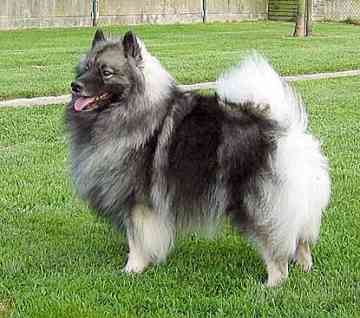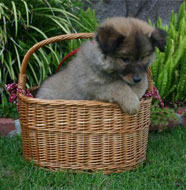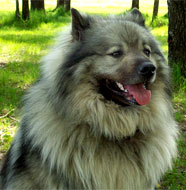| |
|
|
Keeshond Information

Keeshond Facts
| Size |
Large |
| Male Max Weight |
70-90 lb |
| Female Max Weight |
60-80 lb |
| Life Span |
12-15 years |
| Energy Level |
 |
| Ease of Training |
 |
| Grooming |
 |
| Shedding |

|
| Exercise Requirements |

|
| Playfulness |

|
| Affection Level |

|
| Good With Dogs |

|
| Good With Pets |

|
| Good With Strangers |

|
| Watchdog Ability |

|
| Protection Ability |

|
| Cold Tolerance |

|
| Heat Tolerance |

|
Keeshond Temperament
|
The Keeshond is a dog breed that encompassed many personality
traits of the ideal housedog. This breed of dog is reasonably lively and playful. It is
also an extremely attentive and affectionate housedog, making it a great companion for a
child or adult. The Keeshond is always ready for an exciting adventure. However, on the
other hand, this breed can be completely content in just relaxing and taking it easy. The
Keeshond shows personality traits of sensitivity and fast learning skills. This breed of
dog is overall very friendly, yet always has awareness for
danger.
|
Keeshond Upkeep
|
As an extremely lively breed, the Keeshond needs ample exercise
to keep content. Daily moderate exercise such as a good walk on a leash along with an
energetic game can keep this breed happy. The Keeshond can live in the outdoors in
temperate to cool climates. However, since it is an exceptionally social and affectionate
dog breed, the Keeshond prefers to share its time indoors with its family. This dog breed
has a double coat and it needs brushing at least once or twice weekly, and even more
often when shedding.
|
Keeshond Health
|
The Keeshond has a life span of twelve to fourteen years. This
breed of dog does not have any major health concerns. However, some of the more minor
health concerns associated with this dog breed are CHD, epilepsy, and patellar luxation.
Occasionally, renal cortical, hypoplasia, and tetra logy health concerns are seen in the
Keeshond.
|
Keeshond History
|
The Keeshond is part of the family of spitz dogs. However, its
particular origins are unknown. Since the eighteenth century, this breed seems to have
been well recognized in Holland as a companion and watchdog. Later, this dog breed became
known as the barge dog due to its frequent position as watchdog on small vessels
navigating the Rhine River. By some miracle, the Keeshond became involved in the
political events of Holland during the years that led up to the French Revolution. The
leader of the Patriot faction, Kees de Gyselaer, owned a barge dog named Kees. This
particular dog appeared in so many political cartoons that him and his breed became the
symbol of the Patriots, calling them a dog of the people. However, unfortunately for the
Keeshond, the Patriots did not come out on top and many of the dog owners got rid of
their dogs so they would not be recognized as the losing party. Along with these negative
circumstances, the Keeshond also faced more problems when the barges that floated the
Rhine became larger. Because of this, the small Keeshond breed became unpopular as a
barge dog. Yet, regardless of these unfortunate happenings, the Keeshond breed survived
below the radar by the efforts of a couple loyal river boatman and farmers. In 1920, an
effort to rescue the surviving members was made by the Baroness van Hardenbroek. The
breed was in England by 1925 because of how successful she was in obtaining friends for
the Keeshond. Then, finally in 1930, the Keeshond gained AKC recognition. The breed
continued its success, later recovering in its homeland as the national dog of
Holland.
|
Keeshond Pictures
|
Puppies

Middle Aged

Older

|
Keeshond Videos
|
|
|







